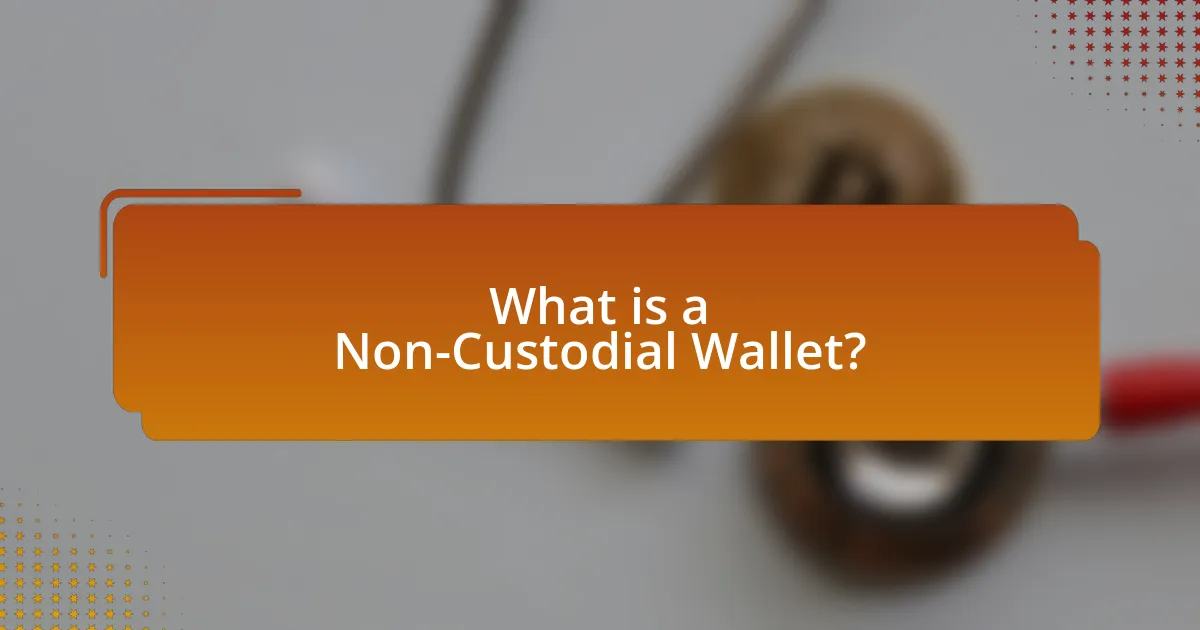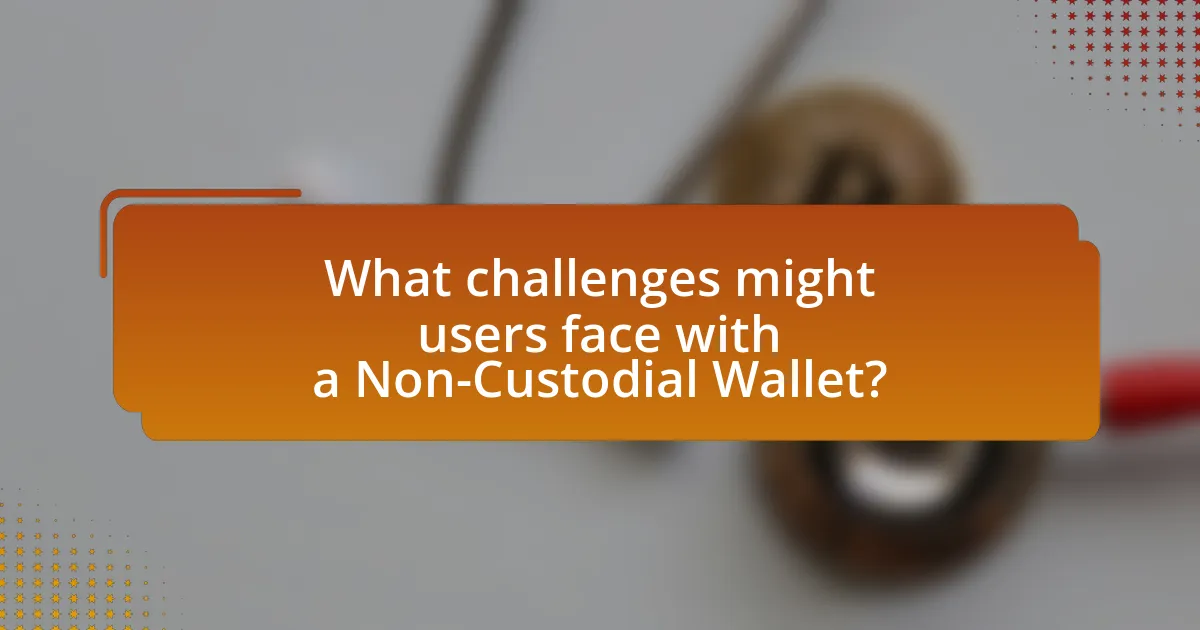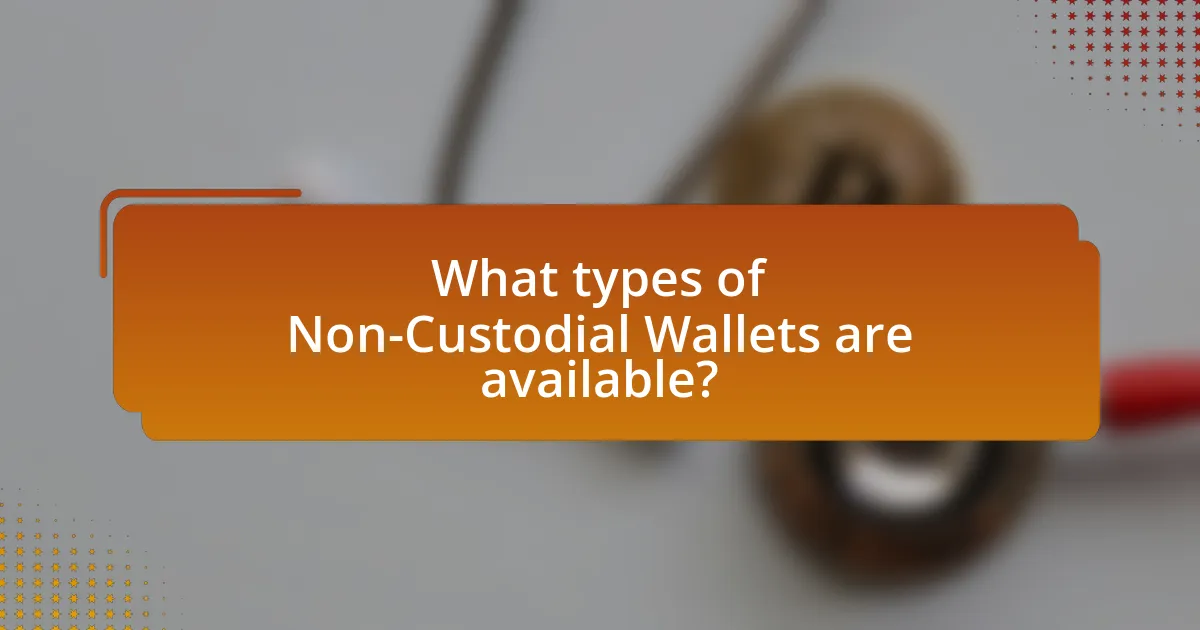A non-custodial wallet is a cryptocurrency wallet that allows users to maintain full control over their private keys and funds, enhancing security and privacy compared to custodial wallets. This article explores the key features and benefits of non-custodial wallets, including user autonomy, reduced reliance on third-party services, and improved transaction privacy. It also addresses potential challenges users may face, such as the risk of losing access to funds and the importance of implementing strong security practices. Additionally, the article outlines different types of non-custodial wallets, their security advantages, and practical tips for effective usage, providing a comprehensive understanding of why non-custodial wallets are increasingly preferred by cryptocurrency users.

What is a Non-Custodial Wallet?
A non-custodial wallet is a type of cryptocurrency wallet that allows users to retain full control over their private keys and funds. Unlike custodial wallets, which are managed by third-party services that hold users’ private keys, non-custodial wallets empower individuals to manage their own assets directly. This autonomy enhances security, as users are not reliant on external entities that could be vulnerable to hacks or mismanagement. The decentralized nature of non-custodial wallets aligns with the core principles of blockchain technology, promoting user sovereignty and privacy.
How does a Non-Custodial Wallet differ from a Custodial Wallet?
A Non-Custodial Wallet differs from a Custodial Wallet primarily in the control of private keys; users of Non-Custodial Wallets retain full ownership and control over their private keys, while Custodial Wallet users rely on a third party to manage their keys. This distinction means that Non-Custodial Wallets provide enhanced security and privacy, as users are not dependent on external entities that could be vulnerable to hacks or mismanagement. According to a report by Chainalysis, custodial services have been targeted in numerous high-profile breaches, emphasizing the risks associated with entrusting private keys to third parties.
What are the key features of a Non-Custodial Wallet?
A Non-Custodial Wallet allows users to maintain full control over their private keys and funds, ensuring enhanced security and privacy. Key features include user-controlled private keys, which eliminate reliance on third-party services, thereby reducing the risk of hacks or mismanagement. Additionally, these wallets often support multiple cryptocurrencies, providing flexibility for users to manage various digital assets in one place. Non-Custodial Wallets also typically offer a user-friendly interface, making it accessible for both beginners and experienced users. Furthermore, they enable seamless transactions without intermediaries, allowing for faster and more cost-effective transfers.
Why is user control important in a Non-Custodial Wallet?
User control is crucial in a non-custodial wallet because it allows individuals to manage their own private keys and funds without relying on third-party services. This autonomy enhances security, as users are less vulnerable to hacks or mismanagement that can occur with custodial wallets, where a third party holds the keys. According to a report by Chainalysis, custodial wallets have been frequent targets for cyberattacks, leading to significant losses for users. By maintaining control over their assets, users can ensure their funds remain secure and accessible only to them, reinforcing the principle of self-sovereignty in cryptocurrency management.
What are the primary benefits of using a Non-Custodial Wallet?
The primary benefits of using a Non-Custodial Wallet include enhanced security, complete control over funds, and increased privacy. Non-Custodial Wallets allow users to retain their private keys, which means they are not reliant on third-party services that could be vulnerable to hacks or mismanagement. This control significantly reduces the risk of losing funds due to external breaches. Additionally, these wallets provide users with greater privacy since transactions do not require personal information to be shared with a custodian, thereby minimizing the risk of data exposure. According to a report by Chainalysis, the decentralized nature of Non-Custodial Wallets contributes to a more secure and private cryptocurrency experience, reinforcing their advantages over custodial alternatives.
How does a Non-Custodial Wallet enhance security for users?
A Non-Custodial Wallet enhances security for users by allowing them to maintain full control over their private keys, which are essential for accessing and managing their cryptocurrency. This control minimizes the risk of hacks or theft associated with centralized exchanges, where users’ funds are stored on third-party servers. According to a report by CipherTrace, in 2020, over $1.8 billion was lost to cryptocurrency theft, primarily from custodial services. By using a Non-Custodial Wallet, users eliminate the vulnerability of relying on a third party, thereby significantly increasing the security of their digital assets.
What advantages does a Non-Custodial Wallet offer in terms of privacy?
A Non-Custodial Wallet offers enhanced privacy by allowing users to maintain full control over their private keys and transaction data. This control means that users do not have to share sensitive information with third parties, reducing the risk of data breaches and unauthorized access. Additionally, transactions made through Non-Custodial Wallets are often pseudonymous, meaning that while transaction details are recorded on the blockchain, they are not directly linked to personal identities. This feature further protects user privacy compared to custodial wallets, where user data is typically stored and managed by a third party.
How can a Non-Custodial Wallet provide greater financial autonomy?
A Non-Custodial Wallet provides greater financial autonomy by allowing users to retain full control over their private keys and funds. This means that individuals are not reliant on third-party services, which can impose restrictions or fees, and they can manage their assets without interference. According to a report by the Cambridge Centre for Alternative Finance, 40% of cryptocurrency users prefer non-custodial solutions for the enhanced security and privacy they offer, reinforcing the idea that these wallets empower users to make independent financial decisions.

What challenges might users face with a Non-Custodial Wallet?
Users of a Non-Custodial Wallet may face challenges such as the risk of losing access to their funds due to lost private keys, which are essential for wallet recovery. Without a centralized authority to assist, users bear full responsibility for their security and recovery processes. Additionally, users may encounter difficulties in managing complex wallet interfaces, which can lead to errors in transactions. A study by the Cambridge Centre for Alternative Finance indicates that 25% of cryptocurrency users have lost access to their wallets, highlighting the significant risk associated with private key management. Furthermore, users may struggle with the lack of customer support, as non-custodial wallets typically do not offer direct assistance, making troubleshooting more challenging.
How can users mitigate risks associated with Non-Custodial Wallets?
Users can mitigate risks associated with non-custodial wallets by implementing strong security practices, such as using hardware wallets for private key storage, enabling two-factor authentication, and regularly updating wallet software. Hardware wallets, like Ledger or Trezor, store private keys offline, significantly reducing the risk of hacking. Two-factor authentication adds an extra layer of security by requiring a second form of verification, making unauthorized access more difficult. Regular software updates ensure that users benefit from the latest security patches and features, further protecting their assets. These practices collectively enhance the security of non-custodial wallets, reducing the likelihood of loss or theft.
What best practices should users follow to secure their Non-Custodial Wallet?
To secure a Non-Custodial Wallet, users should implement strong password practices, enable two-factor authentication (2FA), and regularly back up their wallet. Strong passwords should be complex, unique, and changed periodically to prevent unauthorized access. Enabling 2FA adds an additional layer of security, making it harder for attackers to gain access even if they have the password. Regular backups ensure that users can recover their wallet in case of device loss or failure, safeguarding their assets. According to cybersecurity experts, following these practices significantly reduces the risk of theft and loss in digital asset management.
How can users recover access to their Non-Custodial Wallet if needed?
Users can recover access to their Non-Custodial Wallet by utilizing their recovery phrase or seed phrase, which is a series of words generated during the wallet setup. This recovery phrase allows users to restore their wallet on any compatible wallet application, ensuring they can regain access to their funds even if they lose their device or forget their password. The importance of securely storing this recovery phrase is underscored by the fact that losing it can result in permanent loss of access to the wallet and its contents, as there is no central authority to assist in recovery.

What types of Non-Custodial Wallets are available?
There are several types of non-custodial wallets available, including software wallets, hardware wallets, and paper wallets. Software wallets, which can be desktop or mobile applications, allow users to manage their cryptocurrencies directly on their devices. Hardware wallets are physical devices that store private keys offline, providing enhanced security against online threats. Paper wallets involve printing out the private keys and public addresses on paper, ensuring that the keys are stored completely offline. Each type offers unique advantages in terms of security and accessibility, catering to different user needs and preferences.
What are the differences between software and hardware Non-Custodial Wallets?
Software non-custodial wallets are applications installed on devices like computers or smartphones, while hardware non-custodial wallets are physical devices designed specifically for securely storing cryptocurrencies. Software wallets offer convenience and ease of access, allowing users to manage their assets quickly, but they are more vulnerable to malware and hacking due to their connection to the internet. In contrast, hardware wallets provide enhanced security by storing private keys offline, making them less susceptible to online threats. According to a report by the Blockchain Research Institute, hardware wallets are considered one of the safest options for long-term cryptocurrency storage due to their robust security features.
What are the pros and cons of using software Non-Custodial Wallets?
Software non-custodial wallets offer significant advantages and disadvantages. The primary benefit is that users maintain full control over their private keys, enhancing security and reducing the risk of hacks associated with centralized exchanges. Additionally, non-custodial wallets promote privacy, as transactions do not require personal information, aligning with the ethos of decentralization in cryptocurrency. However, the main drawback is that users are solely responsible for their funds; if they lose access to their wallet or forget their recovery phrase, they cannot retrieve their assets. Furthermore, non-custodial wallets may have a steeper learning curve for beginners compared to custodial options, which can manage transactions on behalf of users.
How do hardware Non-Custodial Wallets enhance security?
Hardware non-custodial wallets enhance security by storing private keys offline, which significantly reduces the risk of hacking and unauthorized access. These wallets utilize secure elements and encryption to protect sensitive information, ensuring that private keys never leave the device. According to a report by the European Union Agency for Cybersecurity, offline storage methods are among the most effective ways to safeguard digital assets against cyber threats. Additionally, hardware wallets often require physical confirmation for transactions, adding an extra layer of security against remote attacks.
What should users consider when choosing a Non-Custodial Wallet?
Users should consider security, user control, and compatibility when choosing a Non-Custodial Wallet. Security is paramount, as these wallets require users to manage their private keys, making them responsible for safeguarding their funds against theft or loss. User control is essential because Non-Custodial Wallets allow individuals to retain full ownership of their cryptocurrencies, unlike custodial options where third parties hold the assets. Compatibility with various cryptocurrencies and platforms is also crucial, as it ensures that users can manage multiple assets seamlessly. According to a report by Chainalysis, the rise in hacks targeting custodial services highlights the importance of security and control in wallet selection.
How do transaction fees vary among different Non-Custodial Wallets?
Transaction fees among different non-custodial wallets vary significantly based on factors such as the blockchain network used, the wallet’s fee structure, and the transaction size. For instance, wallets like Exodus and Electrum may charge different fees depending on the Bitcoin network’s congestion, while Ethereum-based wallets like MetaMask often have variable fees influenced by gas prices. Additionally, some wallets allow users to customize fees, enabling them to choose between faster processing times or lower costs. According to a 2023 analysis by CoinMetrics, transaction fees can range from a few cents to several dollars, depending on these variables, highlighting the importance of selecting a wallet that aligns with the user’s transaction needs and budget.
What features should users prioritize based on their needs?
Users should prioritize security, control over private keys, and user-friendly interfaces when selecting a non-custodial wallet. Security is paramount as it protects users’ assets from hacks and unauthorized access; for instance, non-custodial wallets allow users to manage their private keys, reducing reliance on third parties. Control over private keys ensures that users have full ownership of their cryptocurrencies, which is a fundamental principle of blockchain technology. Additionally, a user-friendly interface enhances the overall experience, making it easier for users to navigate and manage their assets effectively. These features collectively address the core needs of users seeking to safeguard their digital assets while maintaining autonomy and ease of use.
What are some practical tips for using a Non-Custodial Wallet effectively?
To use a Non-Custodial Wallet effectively, prioritize security by enabling two-factor authentication and using strong, unique passwords. This enhances protection against unauthorized access, as studies show that 90% of data breaches are due to weak passwords. Regularly back up your wallet’s recovery phrase in a secure location, as losing this phrase can result in permanent loss of access to your funds. Additionally, keep your wallet software updated to benefit from the latest security features and bug fixes, which are crucial for safeguarding your assets. Finally, be cautious of phishing attempts by verifying URLs and avoiding suspicious links, as phishing attacks account for a significant portion of cryptocurrency thefts.


